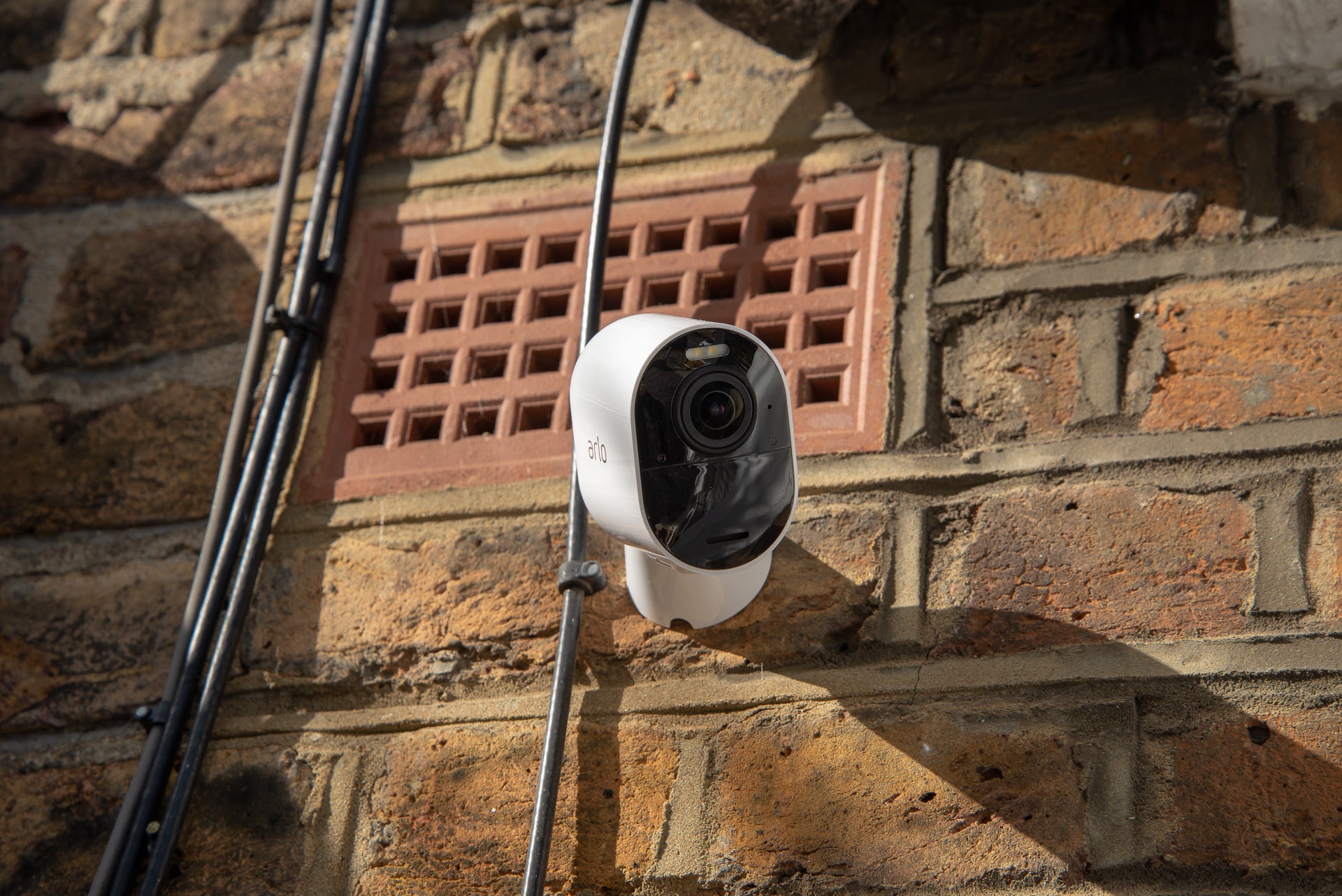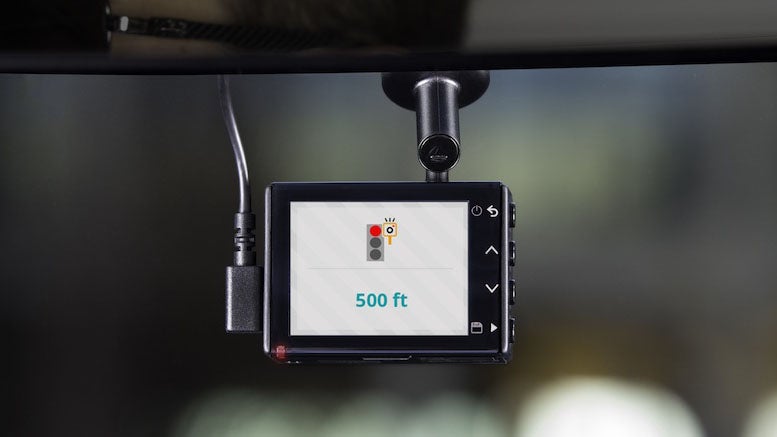Verdict
The Miofive 4K UHD dash cam is incredibly well priced for an UHD dash cam. It’s not badly specified, either, with AI driver assistance features that work well, even it can become annoying. However, with only 64GB of non-upgradeable onboard storage and no easy removal from the car, it’s hard to avoid the impression of a dash cam that’s just a little too compromised.
Pros
- High quality video
- Generally good features including driver aids
- Cheap
Cons
- Non-expandable storage
- No rear camera support
- Only works with the Miofive app
Introduction
Miofive’s 4K UHD dash cam is a compact high-resolution dash cam, offering video coverage from the front of any vehicle.
It’s the cheapest 4K dash cam I’ve reviewed, but you wouldn’t know it to look at – or by its feature set. This camera includes a small screen and some AI-powered driving aids, but it’s also rather compromised.
Design and features
- Compact and smart looking
- GPS positioning, parking mode, screen and Wi-Fi
- Compromised mount and storage
You really wouldn’t know this camera was so keenly priced by unpacking and looking at it. It’s a compact rectangle, about twice the overall size of a Mars bar.
At the front there’s a small bulge housing a lens with a 140° field of view, while its largely unadorned back has just a small display with no visible controls. The camera comes with the usual length of USB cable and a spudger to lever this behind your car’s front pillar trim, but the supplied cigarette power adaptor only has one USB port – no spares.
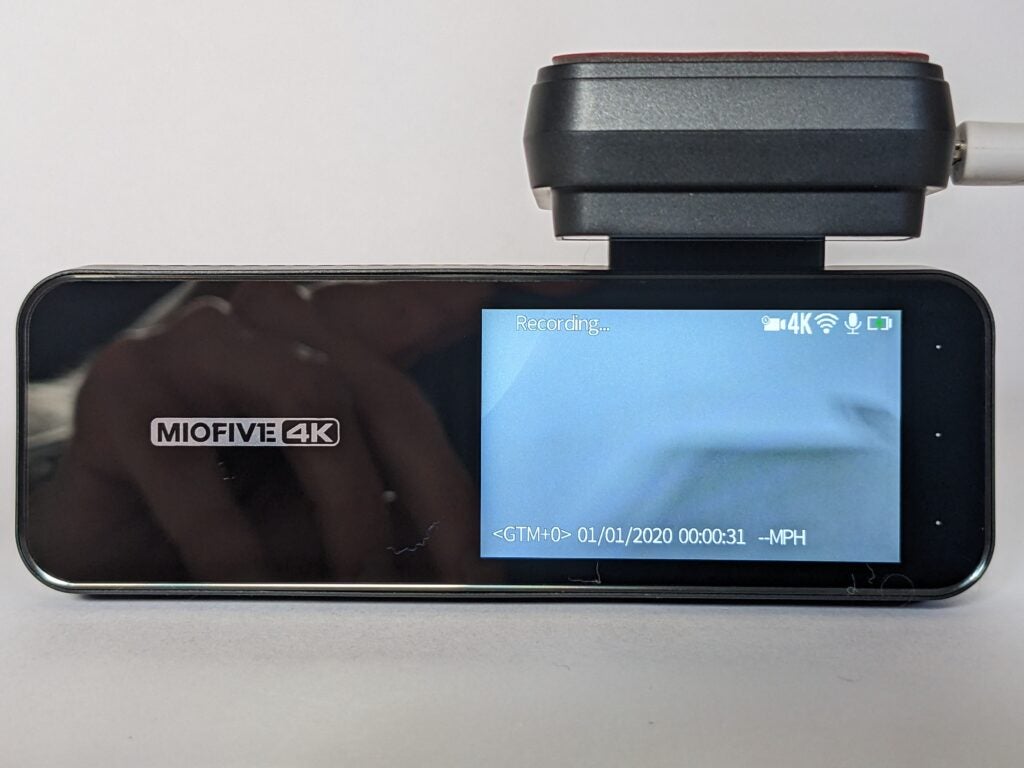
Unusually, this camera can’t be separated from its mount. It’s supplied with a clear electrostatic sticker, which you place on the windscreen first before attaching the camera’s sticky pad to it. It’s a better way of fixing – and much easier to remove – than simply sticking a mount to the windscreen, and it also came in handy while I perfected the dash cam’s aim. However, the camera’s not designed to be taken out of the vehicle once you’ve attached it.
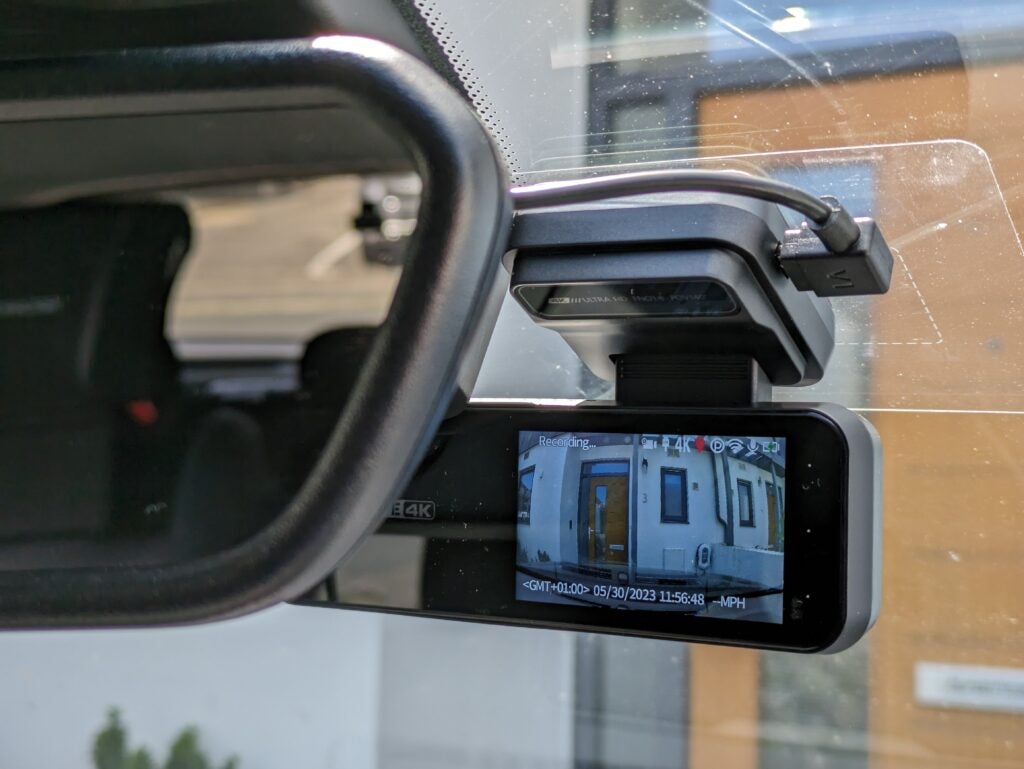
This wouldn’t necessarily be a problem if the Miofive 4K UHD dash cam had removable storage, but, like the Road Angel Halo Ultra, it’s stuck with just 64GB of onboard space. If that sounds like a lot, know that each minute-long segment of video eats up 234MB, and at that rate you’ll be overwriting your oldest videos within about four and a half hours. If you witness or have an incident on a longer journey, you’ll need to remember to download the videos at a rest stop, or risk losing them.
The only way to view and download videos from this camera is to connect to it via Wi-Fi and use Miofive’s smartphone app. Happily, this is better than many, working well to give you access to recorded videos and a range of settings. You can browse movies and download one or more at a time to your phone, but even over 5GHz Wi-Fi each file transfer takes around 30 seconds, and you can’t do anything else in the app – like browse to a second incident – while it’s ongoing.
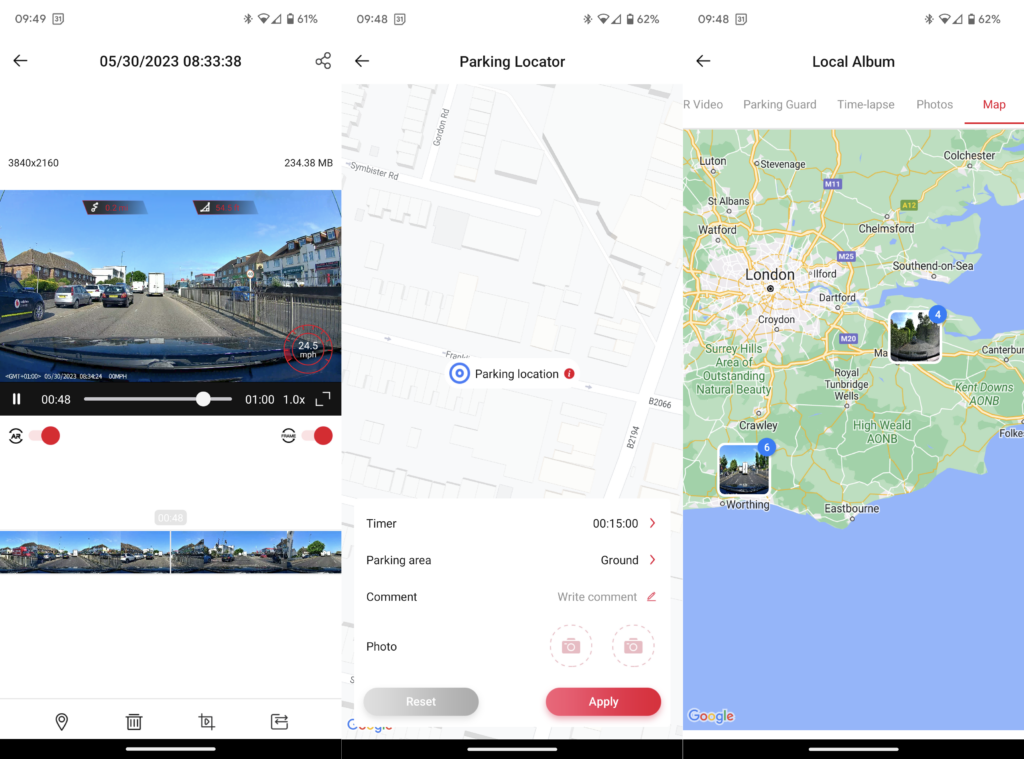
Turn on the ignition and you’ll discover that this is an unnecessarily chatty dash cam. From “Hi, Miofive is here for you” every time it boots, through “Miofive continues to serve” when the screen powers down, to its various AI assistance prompts, you’ll hear a lot from it while driving.
You can turn off the AI warnings individually, but sadly you can’t silence the less meaningful messages without also muting all of the AI-driven warnings.
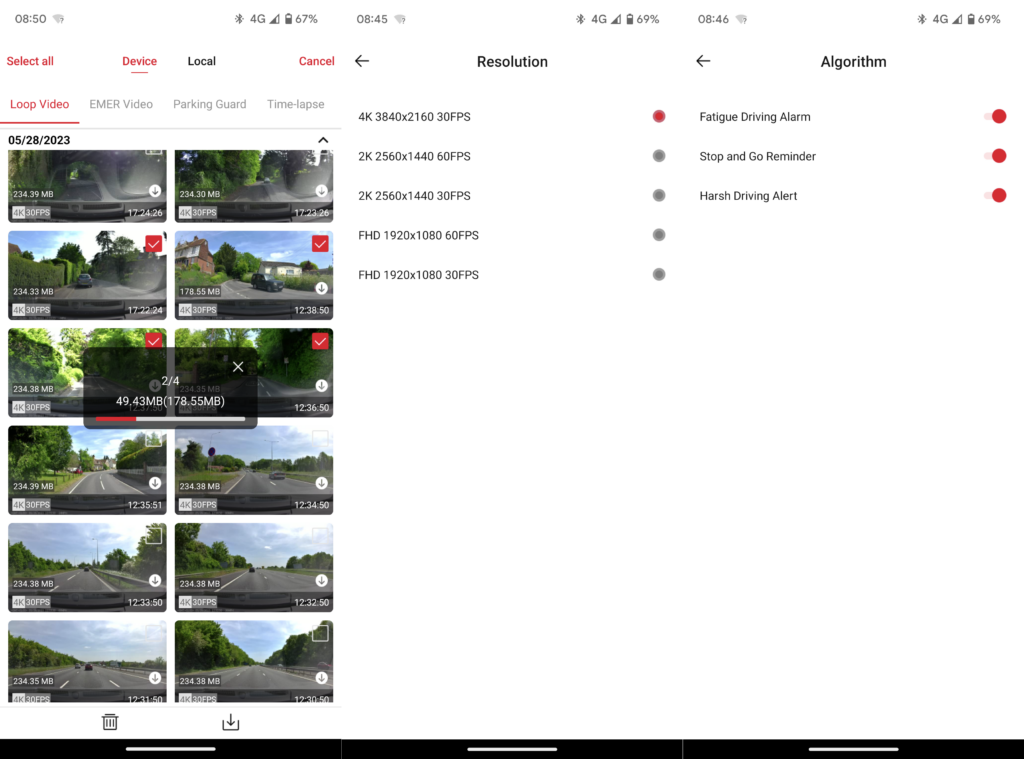
Although this camera’s 5.6cm colour screen is crisp, and useful for aiming and status checks, it’s not especially easy to use the menu. It’s navigated by three touch-sensitive areas to the right, and can be a bit fiddly. Miofive doesn’t supply a hardwiring kit as standard, but you’ll need one to get the best from the parking and time lapse modes, both of which offer protection when the vehicle’s parked.
Aside from removable storage, the Miofive 4K UHD dash cam’s major limitation is that you can’t upgrade it with a rear-view camera. For £250 you can buy essentially the same dash cam with a 2K rear-facing unit, but that’s a slightly different model with 128GB of onboard storage. The standalone model reviewed here doesn’t have the necessary port for you to add the rear module later.
Performance and video quality
- Great video by day
- Good video at night
- Decent AI performance
Most dash cams perform reasonably by day, but the Miofive 4K UHD was one of the best I’ve tested. With a wide dynamic range, it could expose flawless blue skies, without losing detail among heavily shaded parts of the road.
In bright light, individual frames were extremely crisp, increasing the chances you’d be able to pick out important details. As an example, look at the vigorously flapping pigeon in this shot, perfectly exposed and frozen in the top left of the frame.
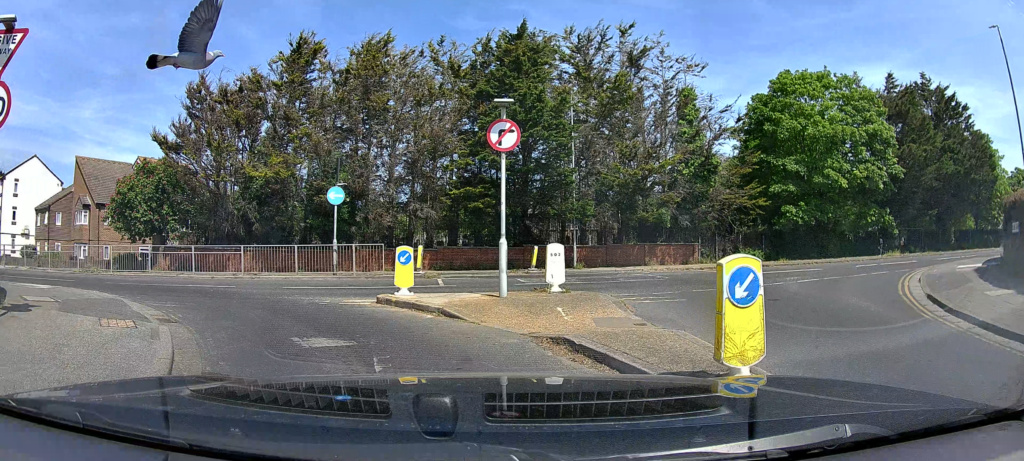
I tested this camera in the dry, bright spell at the end of May 2023, so I couldn’t expose it to dingy days or rain. All the same, it coped well in lower light and with dappled and slanting sunlight. In some situations it would have benefited from a polarising filter, which removes cabin reflections, but unfortunately Miofive doesn’t sell one – you’d have to rig something up yourself.
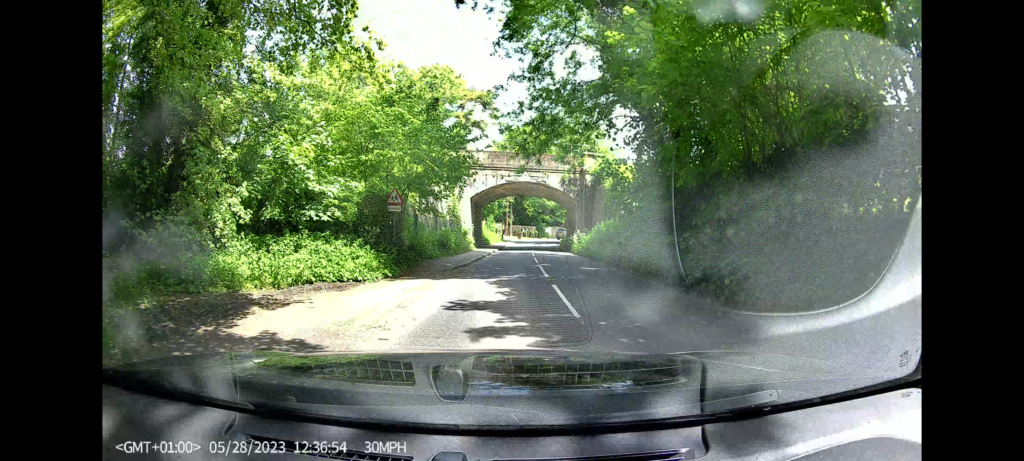
This is a fairly good dash cam at night. Again, it could capture relatively crisp individual frames on my late night spin around a city centre block, allowing me to make out several number plates – always the sternest test given their propensity to wash out completely under headlights.
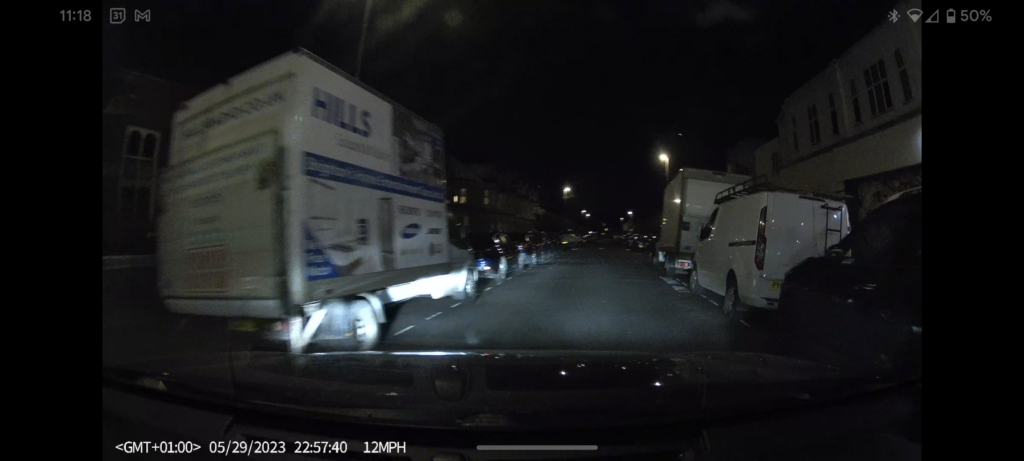
However, this camera didn’t do a great job of capturing more dimly lit areas, and you can’t adjust its exposure to correct that. Away from the road, building fronts and doorways were mired in gloom, while some patches between streetlights were just a bit too dark to make out important details.
The Road Angel Halo Ultra was much more impressive here. In this comparison, the Miofive is to the left, the Road Angel to the right.
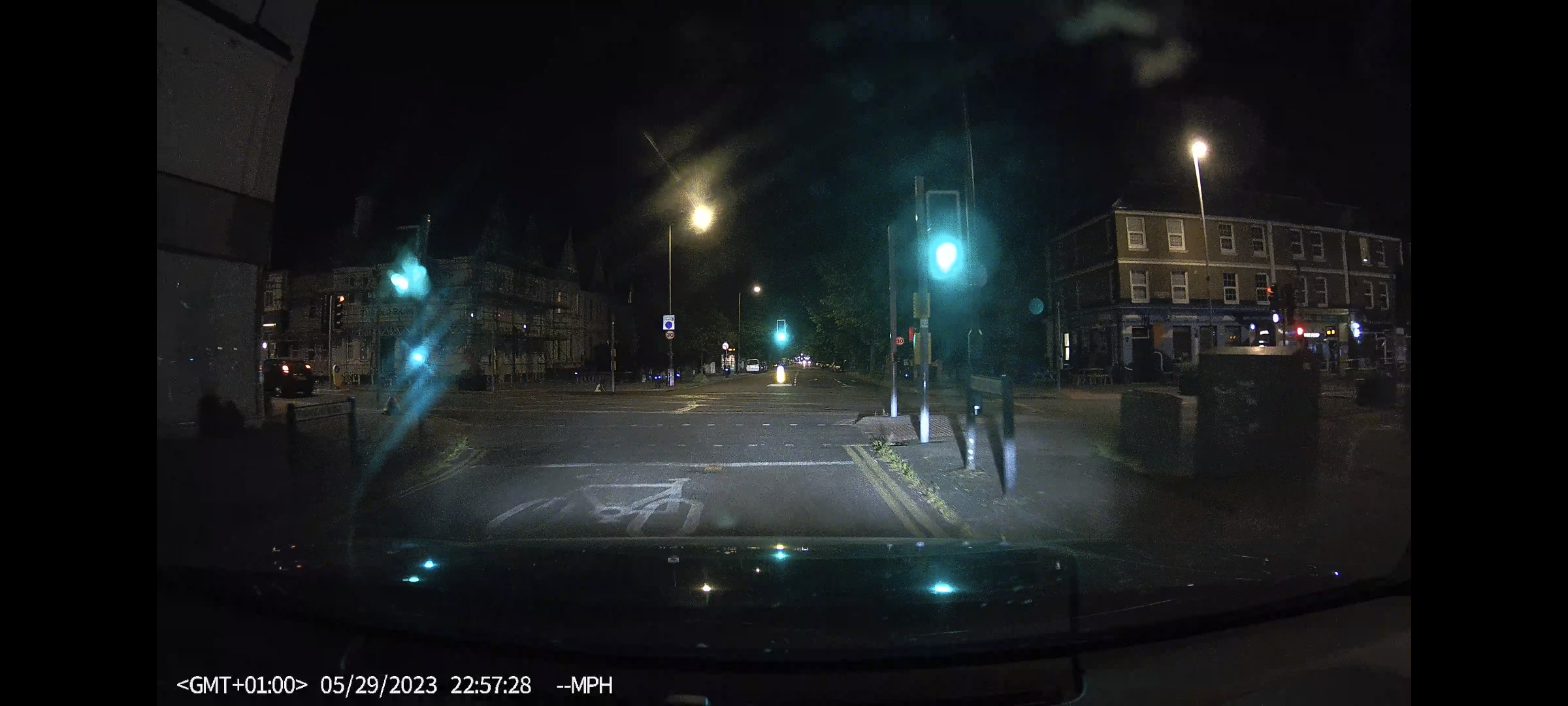
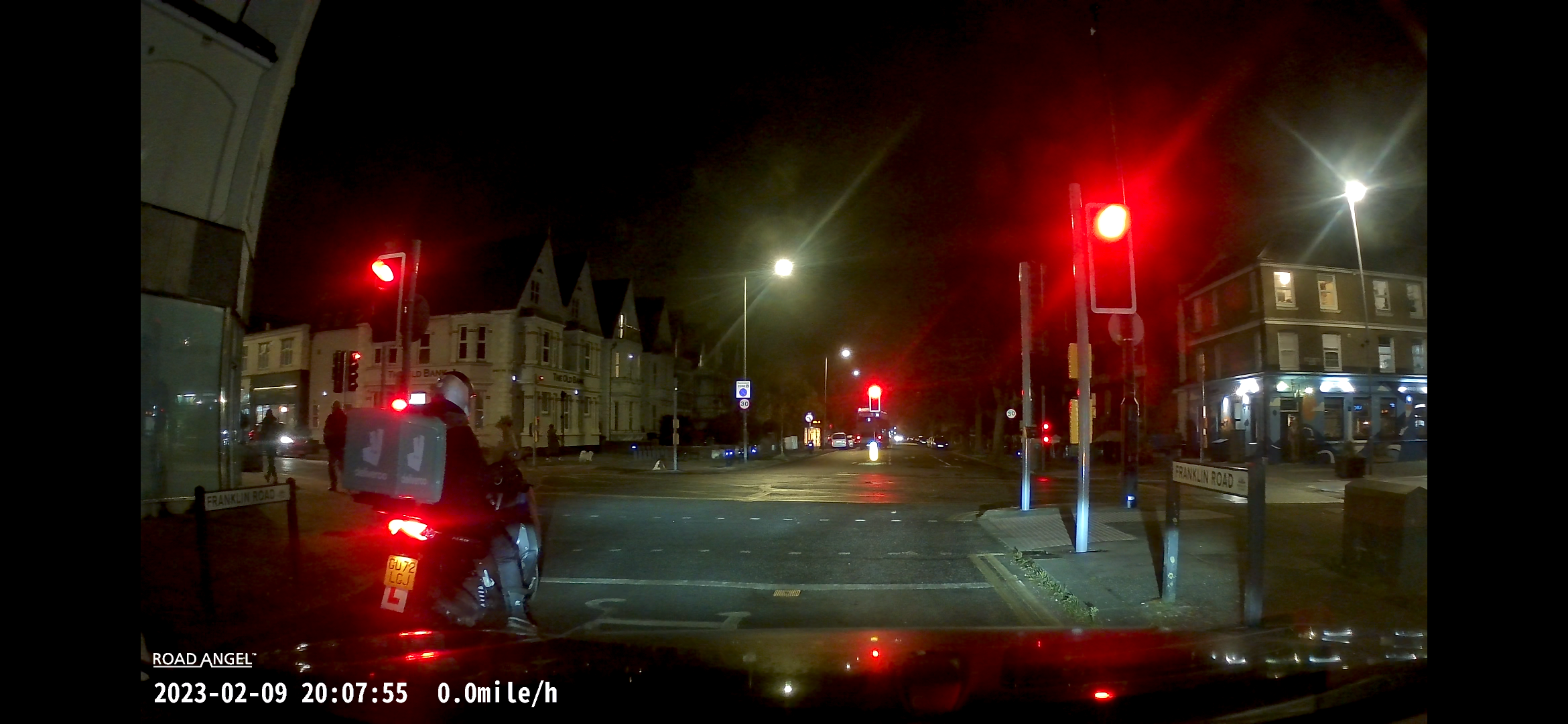
I have mixed feelings about the driver assistance features on dashcams, which in my experience are not as accurate as those built into newer cars. This camera offers stop and go alarms to warn you when traffic ahead is moving off or coming to a halt. It also chides you about ‘harsh’ driving, and can look out for signs of fatigue, but it can’t warn you if you’re drifting out of a lane.
I found the setting off warning completely consistent and reliable, but over a couple of weeks’ driving I never heard the stop reminder. Less surprisingly, the fatigue alarm didn’t sound once, either. In the city centre, the camera was a little too eager to tell me off for low-speed 90° turns at city junctions and moderate speed at roundabouts, but its warnings were generally more consistent and reliable than many other cameras I’ve tested.
Latest deals
Should you buy it?
If you want the cheapest 4K dash cam:
If you want the highest video capture quality possible, this is the dash cam model for you.
You want more storage space:
This dash cam is just a bit compromised compared to the best, with non-expandable storage meaning you can only record up to four and a half hours of footage at a time.
Final Thoughts
There’s lots to like about this dash cam, such as its slimline shape, useful AI features and great daytime 4K footage. Unfortunately there are also a few annoyances: it’s too chatty, it can’t be removed easily from your vehicle, and it’s limited somewhat by its non-expandable, non-removable storage.
If you want a cheap 4K dash cam it’s a good one, but Road Angel’s Halo Ultra has it beaten for video quality – especially at night – and more expensive alternatives like the Nextbase 622GW are better all-rounders.
How we test
We test every dash cam we review thoroughly over an extended period of time. We use standard tests to compare features properly. We’ll always tell you what we find. We never, ever, accept money to review a product.
Find out more about how we test in our ethics policy.
FAQs
This camera only covers the front of your car, and there’s no port for a rear-facing expansion module.
This camera doesn’t have a removable memory card, and it’s semi-permanently installed in your vehicle – you can’t clip it out of its mount, so the only way to get it out of the car is to pull its electrostatic sticker off your windscreen. That’s not something you’ll want to do often, and even if you did, it doesn’t appear as a drive when you connect it to a PC via USB.
The only way to view recordings on a computer is to download them to your phone, then find and copy them in a file app to a cloud or network drive, from which you can transfer them to a PC. It’s a faff.
UK RRP
USA RRP
EU RRP
CA RRP
AUD RRP
Quiet Mark Accredited
Size (Dimensions)
Weight
ASIN
Release Date
First Reviewed Date
Model Number
Dash cam front camera resolution
Dash cam memory card slot
Dash cam rear camera
Dash cam GPS
Dash cam Wi-Fi
Dash cam parking mode
Dash cam screen size
Dash cam screen resolution
Verdict
The Miofive 4K UHD dash cam is incredibly well priced for an UHD dash cam. It’s not badly specified, either, with AI driver assistance features that work well, even it can become annoying. However, with only 64GB of non-upgradeable onboard storage and no easy removal from the car, it’s hard to avoid the impression of a dash cam that’s just a little too compromised.
Pros
- High quality video
- Generally good features including driver aids
- Cheap
Cons
- Non-expandable storage
- No rear camera support
- Only works with the Miofive app
Introduction
Miofive’s 4K UHD dash cam is a compact high-resolution dash cam, offering video coverage from the front of any vehicle.
It’s the cheapest 4K dash cam I’ve reviewed, but you wouldn’t know it to look at – or by its feature set. This camera includes a small screen and some AI-powered driving aids, but it’s also rather compromised.
Design and features
- Compact and smart looking
- GPS positioning, parking mode, screen and Wi-Fi
- Compromised mount and storage
You really wouldn’t know this camera was so keenly priced by unpacking and looking at it. It’s a compact rectangle, about twice the overall size of a Mars bar.
At the front there’s a small bulge housing a lens with a 140° field of view, while its largely unadorned back has just a small display with no visible controls. The camera comes with the usual length of USB cable and a spudger to lever this behind your car’s front pillar trim, but the supplied cigarette power adaptor only has one USB port – no spares.

Unusually, this camera can’t be separated from its mount. It’s supplied with a clear electrostatic sticker, which you place on the windscreen first before attaching the camera’s sticky pad to it. It’s a better way of fixing – and much easier to remove – than simply sticking a mount to the windscreen, and it also came in handy while I perfected the dash cam’s aim. However, the camera’s not designed to be taken out of the vehicle once you’ve attached it.

This wouldn’t necessarily be a problem if the Miofive 4K UHD dash cam had removable storage, but, like the Road Angel Halo Ultra, it’s stuck with just 64GB of onboard space. If that sounds like a lot, know that each minute-long segment of video eats up 234MB, and at that rate you’ll be overwriting your oldest videos within about four and a half hours. If you witness or have an incident on a longer journey, you’ll need to remember to download the videos at a rest stop, or risk losing them.
The only way to view and download videos from this camera is to connect to it via Wi-Fi and use Miofive’s smartphone app. Happily, this is better than many, working well to give you access to recorded videos and a range of settings. You can browse movies and download one or more at a time to your phone, but even over 5GHz Wi-Fi each file transfer takes around 30 seconds, and you can’t do anything else in the app – like browse to a second incident – while it’s ongoing.

Turn on the ignition and you’ll discover that this is an unnecessarily chatty dash cam. From “Hi, Miofive is here for you” every time it boots, through “Miofive continues to serve” when the screen powers down, to its various AI assistance prompts, you’ll hear a lot from it while driving.
You can turn off the AI warnings individually, but sadly you can’t silence the less meaningful messages without also muting all of the AI-driven warnings.

Although this camera’s 5.6cm colour screen is crisp, and useful for aiming and status checks, it’s not especially easy to use the menu. It’s navigated by three touch-sensitive areas to the right, and can be a bit fiddly. Miofive doesn’t supply a hardwiring kit as standard, but you’ll need one to get the best from the parking and time lapse modes, both of which offer protection when the vehicle’s parked.
Aside from removable storage, the Miofive 4K UHD dash cam’s major limitation is that you can’t upgrade it with a rear-view camera. For £250 you can buy essentially the same dash cam with a 2K rear-facing unit, but that’s a slightly different model with 128GB of onboard storage. The standalone model reviewed here doesn’t have the necessary port for you to add the rear module later.
Performance and video quality
- Great video by day
- Good video at night
- Decent AI performance
Most dash cams perform reasonably by day, but the Miofive 4K UHD was one of the best I’ve tested. With a wide dynamic range, it could expose flawless blue skies, without losing detail among heavily shaded parts of the road.
In bright light, individual frames were extremely crisp, increasing the chances you’d be able to pick out important details. As an example, look at the vigorously flapping pigeon in this shot, perfectly exposed and frozen in the top left of the frame.

I tested this camera in the dry, bright spell at the end of May 2023, so I couldn’t expose it to dingy days or rain. All the same, it coped well in lower light and with dappled and slanting sunlight. In some situations it would have benefited from a polarising filter, which removes cabin reflections, but unfortunately Miofive doesn’t sell one – you’d have to rig something up yourself.

This is a fairly good dash cam at night. Again, it could capture relatively crisp individual frames on my late night spin around a city centre block, allowing me to make out several number plates – always the sternest test given their propensity to wash out completely under headlights.

However, this camera didn’t do a great job of capturing more dimly lit areas, and you can’t adjust its exposure to correct that. Away from the road, building fronts and doorways were mired in gloom, while some patches between streetlights were just a bit too dark to make out important details.
The Road Angel Halo Ultra was much more impressive here. In this comparison, the Miofive is to the left, the Road Angel to the right.


I have mixed feelings about the driver assistance features on dashcams, which in my experience are not as accurate as those built into newer cars. This camera offers stop and go alarms to warn you when traffic ahead is moving off or coming to a halt. It also chides you about ‘harsh’ driving, and can look out for signs of fatigue, but it can’t warn you if you’re drifting out of a lane.
I found the setting off warning completely consistent and reliable, but over a couple of weeks’ driving I never heard the stop reminder. Less surprisingly, the fatigue alarm didn’t sound once, either. In the city centre, the camera was a little too eager to tell me off for low-speed 90° turns at city junctions and moderate speed at roundabouts, but its warnings were generally more consistent and reliable than many other cameras I’ve tested.
Latest deals
Should you buy it?
If you want the cheapest 4K dash cam:
If you want the highest video capture quality possible, this is the dash cam model for you.
You want more storage space:
This dash cam is just a bit compromised compared to the best, with non-expandable storage meaning you can only record up to four and a half hours of footage at a time.
Final Thoughts
There’s lots to like about this dash cam, such as its slimline shape, useful AI features and great daytime 4K footage. Unfortunately there are also a few annoyances: it’s too chatty, it can’t be removed easily from your vehicle, and it’s limited somewhat by its non-expandable, non-removable storage.
If you want a cheap 4K dash cam it’s a good one, but Road Angel’s Halo Ultra has it beaten for video quality – especially at night – and more expensive alternatives like the Nextbase 622GW are better all-rounders.
How we test
We test every dash cam we review thoroughly over an extended period of time. We use standard tests to compare features properly. We’ll always tell you what we find. We never, ever, accept money to review a product.
Find out more about how we test in our ethics policy.
FAQs
This camera only covers the front of your car, and there’s no port for a rear-facing expansion module.
This camera doesn’t have a removable memory card, and it’s semi-permanently installed in your vehicle – you can’t clip it out of its mount, so the only way to get it out of the car is to pull its electrostatic sticker off your windscreen. That’s not something you’ll want to do often, and even if you did, it doesn’t appear as a drive when you connect it to a PC via USB.
The only way to view recordings on a computer is to download them to your phone, then find and copy them in a file app to a cloud or network drive, from which you can transfer them to a PC. It’s a faff.
UK RRP
USA RRP
EU RRP
CA RRP
AUD RRP
Quiet Mark Accredited
Size (Dimensions)
Weight
ASIN
Release Date
First Reviewed Date
Model Number
Dash cam front camera resolution
Dash cam memory card slot
Dash cam rear camera
Dash cam GPS
Dash cam Wi-Fi
Dash cam parking mode
Dash cam screen size
Dash cam screen resolution




















